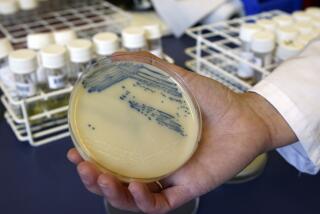Science / Medicine : Attacking the Common Cold : Research on Chemical Bradykinin Seen as Promising
- Share via
There is a promising new concept in medication forming on the horizon that may soon alter the way doctors treat colds, allergies, asthma and pain. The research centers on a remarkable chemical called bradykinin.
Most cold medications contain antihistamines, which work by blocking histamine--chemicals that are released by the action of bradykinin. But if bradykinin were inhibited and the other chemicals were never produced, the therapeutic benefits could be enormous.
Bradykinin is one of the most powerful pain-inducing chemicals in nature, researchers say. It is released after an injury to the body occurs, and its importance is twofold: It sends pain signals shooting up the nerve fibers to the brain, and it initiates the mechanics of healing at the site of the injury.
Waits for Invaders
Bradykinin circulates in the bloodstream as large, inactive protein molecules until something happens that the body sees as invasive--inhaling pollen, for example, in the case of someone susceptible to hay fever--and the complex sequence begins.
A specific enzyme activates bradykinin by cleaving it from the blob of protein to which it is attached. The potent bradykinin molecules then cause muscles to contract, capillaries to dilate (which lowers blood pressure) and fluid to accumulate. These reactions show up as shortness of breath, congestion, sore throat and other all-too-familiar cold symptoms.
In addition, bradykinin stimulates the release of other crucial infection-fighting chemicals, such as prostaglandins, white blood cells and--significantly--histamine. These chemicals affect the body in much the same way as bradykinin does, and researchers are still not certain how all these substances work together.
Bradykinin may run in a kind of relay race, handing its chemical baton to histamine, prostaglandins, and other biologically active agents, which will then be induced to go into action themselves. Or it may act independently, causing all the resultant symptoms itself.
“Bradykinin will attract histamine and the body’s other defense mechanisms, but more likely it works directly,” said David Proud of Johns Hopkins University School of Medicine.
Turning It Off
The way to prove bradykinin’s contribution to cold symptoms, asthma, pain or whatever else it may be involved in, researchers say, is to “turn off” the bradykinin and see what happens. Scientists like John Stewart and Ray Vavrek at the University of Colorado have been seeking ways to inhibit bradykinin by fooling susceptible tissue with a kind of impostor bradykinin, called antagonists.
Stewart and Vavrek knew that bradykinin transmits its chemical messages by docking at the protein receptor sites that are on various cells. Stewart and Vavrek had to synthesize an impotent molecule that looked so much like bradykinin as to be accepted by the receptor.
Without anywhere to dock, the real bradykinin molecules drift about powerlessly. Meanwhile, the impostor bradykinin, with one or two amino acids changed or its structure altered in some subtle way, binds at the receptor site, where it can partially or completely terminate bradykinin activity.
Stewart and Vavrek have synthesized more than 300 antagonists and are able to selectively prohibit an activity while allowing others.
Developed Into Spray
Some of the antagonists are being developed into a nasal spray by Nova Pharmaceutical Co. in Baltimore. The road from research laboratory to drugstore shelf is a long one, but Nova officials are optimistic. The company has received patent approval for its bradykinin blocker and is awaiting Federal Drug Administration approval to conduct clinical trials.




